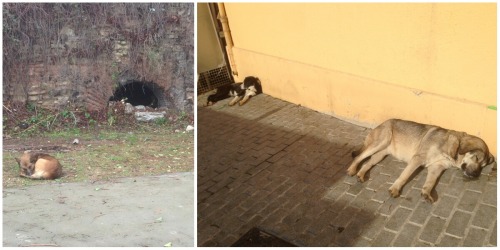
ANAMED Fellow Han Hsien Liew writes about Istanbul’s street dogs, ‘with their heads down and tails hanging low’ with inspiration to visit the exhibit titled ‘The Four-Legged Municipality: Street Dogs of Istanbul’ at the Istanbul Research Institute…
Quite an entitled bunch, they approach people sitting outside cafes for a nice stroke and glare at you incessantly at restaurants until you offer them food. If their wishes are unfulfilled, they are ever ready to help themselves by brushing their fur coats against your jeans or pounce on the table to sneak away with a piece of meat. This diva-like demeanor is quite in contrast with their canine counterparts, the street dogs of Istanbul. While the cats do live up to their name as the “secret rulers of the city” (see the blog post by Laura Picht), the street dogs, with their heads down and tails hanging low, come closer to the image of the downtrodden, destitute, and overlooked segments of society. Their reputation acquired over time is nonetheless a multifaceted one: loyal neighbors who are as Istanbulite as the city’s human inhabitants since the time of Mehmed II; municipal cleaners by nightfall eating up the city’s food wastes; patrols guarding households in territories they’ve considered their own. For European travelers, especially in Galata and Pera, they were yet another symbol of oriental backwardness, unlike the sanitized, dog-free streets of Europe. In Orhan Pamuk’s latest novel translated into English, A Strangeness in My Mind, the protagonist Mevlut has a deep-seated fear of dogs who are said to attack at the smell of fear and often linger around the old cemeteries of Istanbul.
Being more of a dog person myself, I have grown very fond of these four-legged dwellers of Istanbul over the months spent here. My first impression of them when I first visited the city in the summer of 2013 was that they were huge and looked very well fed. Certainly not the average mongrel I usually encounter in my hometown of Malaysia. My partner, who visited last month, remarked to me, “These are wolves!” If not seen walking around, they are usually napping on the street or in front of some cafe or store, perhaps the most common position one would find them in, which I have found rather amusing yet endearing at the same time. Witnessing this, the Italian writer Edmondo de Amicis wrote in 1874 that “Laziness is the distinguishing quality of the Constantinople dogs.” But the way I see it, to be able to sleep the entire day away amidst the hustle and bustle of Istanbul could also mean an age-old familiarity and comfort with the rhythms of the city unmatched by anyone/thing else.

Quite unforgettable was a stare-down I witnessed between a dog and a cat in Cihangir, which conjured up scenes from the 2001 Warner Bros. film Cats & Dogs, in which cats led by an overbearing white Persian cat named Mr. Tinkles organize a global conspiracy to make humans allergic to dogs, while the latter loyally defend their human masters. Our cat here eventually cut short the static confrontation by running off, only to have the still-irritated dog run after it in pursuit.

Mr. Tinkles.
Dog lovers should definitely check out the exhibit titled “The Four-Legged Municipality: Street Dogs of Istanbul” at the Istanbul Research Institute (İstanbul Araştırmaları Enstitüsü), which runs till 11 March 2017. On display are photographs, magazines, travel journals, and postcards from the late 19th to early 20th century pertaining to these four-legged “citizens” of Istanbul, as the exhibit portrays them to be. One also comes across quotes regarding the street dogs from European writers traveling in Istanbul in the late 19th century. The dizzying array of material on display aside, the overall message is clear: the “people’s Islam” (unlike the more legalistic version espoused by the jurists) kept the dogs as fellow inhabitants of the city; 19th-century Ottoman westernization efforts drove them out. Indeed, a substantial part of the exhibit is dedicated to the beginning of the exile of dogs under Sultan Mahmud II up until the great decaninization of 1910, during which around 80,000 dogs were removed from the streets and shipped off to the island of Oxia (Sivriada) and abandoned there without food. According to some reports, tragic howls could be heard by boats sailing close. Despite these efforts, the street dogs are still here with us in Istanbul, and it is as if they had braved the sea and swam back. Although the exhibit ultimately feels more like a tribute to than a history of “man’s best friend” in Istanbul, it’s still heartwarming to see the street dogs get their share of public representation.

